Ontario Economic Accounts
Learn about Ontario’s economic performance and outlook for the first quarter of 2021.
View the related data tables at Ontario’s Open Data Catalogue.
Recommended for you
Economic accounts
Highlights
Ontario economy grows in Q1
Chart 1: Ontario GDP, first quarter 2021

Source: Ontario Ministry of Finance.
Accessible description of chart- Ontario’s real gross domestic product (GDP) increased by 1.2% in the first quarter (January, February, March) of 2021, following a 2.0% gain in the fourth quarter of 2020. Ontario’s real GDP was 1.8% below the level prior to the covid 19 pandemic in 2019Q4.
- First quarter growth was driven by higher investment in residential structures and more modest gains in non-residential construction and household spending.
- Growth was moderated by net trade and lower machinery and equipment investment.
- Nominal GDP advanced 4.0%, after rising 3.6% in the fourth quarter.
- Economic production, measured on an industry basis, increased 1.3% in the first quarter. Output in both goods-producing (+1.4%) and service-producing (+1.2%) industries increased.
Expenditure details
Real GDP up in Q1
Ontario’s real GDP rose 1.2% in the first quarter, following a 2.0% gain in the fourth quarter of 2020.
Chart 2: Real GDP growth
Per cent
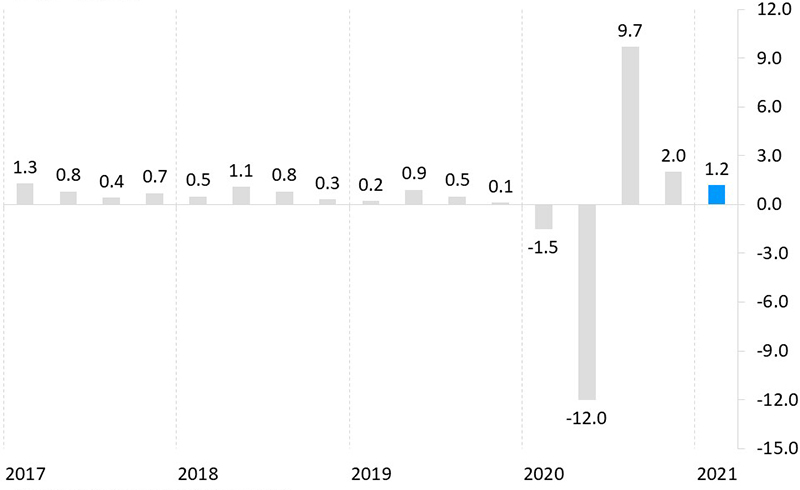
Source: Ontario Ministry of Finance.
Accessible description of chartHousehold consumption spending grew 0.5%, after edging up 0.1% in the fourth quarter. Spending on non-durable goods advanced 1.2%. Spending on services edged up 0.4%, while spending on semi-durable (+0.1%) and durable (−0.2%) goods were little changed.
Total business investment spending increased by 8.1% in the first quarter, with residential construction (+14.1%) being the main contributor to growth. All three components of residential investment spending increased, led by ownership transfer costs reflecting strong home resales. Business investment in intellectual property products (+3.4%) and non-residential structures (+1.0%) increased in the first quarter while machinery and equipment investment (−2.8%) declined.
Chart 3: Real GDP change by expenditure component
Per cent, 2021Q1
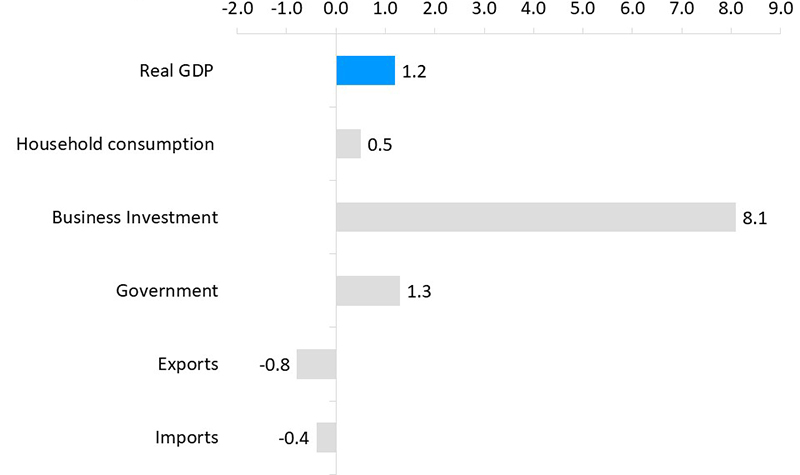
Source: Ontario Ministry of Finance.
Accessible description of chartExports declined 0.8% in the quarter, while imports were down by 0.4%. International exports declined 0.6%, while international imports remained unchanged. Interprovincial exports (−1.1%) and imports (−1.3%) both decreased in the quarter.
Businesses drew down $4.0 billion worth of inventories in the first quarter, following a $0.2 billion depletion in the previous quarter.
Chart 4: Real export and import growth
Per cent

Source: Ontario Ministry of Finance.
Accessible description of chartIncome details
Nominal GDP rises
Ontario’s nominal GDP increased 4.0% in the first quarter, following gains of 11.9% in the third quarter and 3.6% in the fourth quarter of 2020.
Chart 5: Nominal GDP growth
Per cent
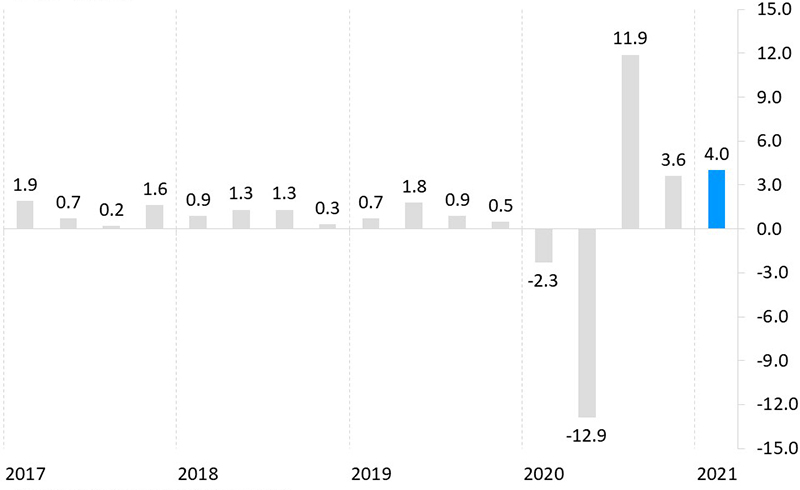
Source: Ontario Ministry of Finance.
Accessible description of chartCompensation of employees, which includes both wages and salaries and supplementary labour income, advanced 2.6%, after increasing 2.6% in the fourth quarter of 2020.
Net operating surplus of corporations increased 17.1%, following gains of 27.0% in the third quarter and 0.3% in the fourth quarter of 2020.
Net mixed income, which is comprised of farm income, unincorporated business income and rental income, grew by 2.9%, after increasing 1.2% in the previous quarter.
Chart 6: Nominal GDP change by income component,
Per cent, 2021Q1

Source: Ontario Ministry of Finance.
Accessible description of chartThe savings rate rose from 11.1% in the fourth quarter to 13.0% in the first quarter of 2021.
Chart 7: Compensation of employees growth
Per cent

Source: Ontario Ministry of Finance.
Accessible description of chartPrice details
Economy-wide prices
Economy-wide prices, as measured by the implicit price index for GDP, rose 2.8% in the first quarter of 2021, its highest quarterly advance since early 1991.
Chart 8: Economy-wide price growth
Per cent

Prices for household consumption expenditures rose 0.3%, after increasing by 0.5% in the fourth quarter. Prices were higher for several expenditure components, including autos, furniture and appliances and gasoline.
Business investment prices increased 4.1%, driven by a record 6.7% rise in residential construction prices. Prices for non-residential construction were also elevated in the quarter, rising 3.2%.
Chart 9: Price change by expenditure component
Per cent, 2021Q1
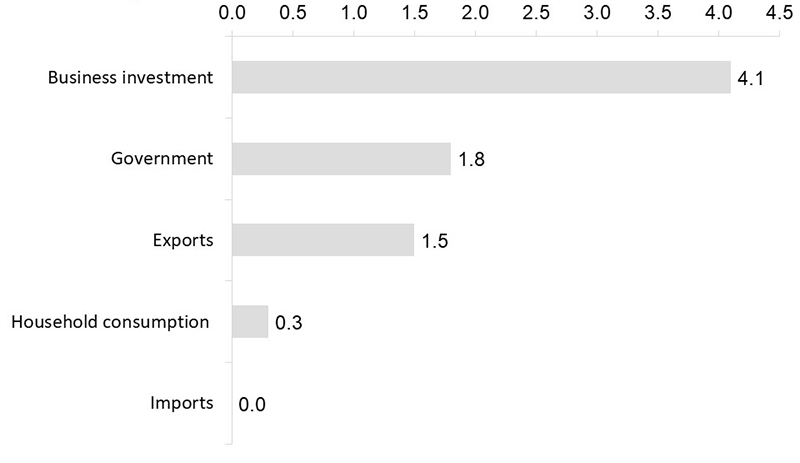
Source: Ontario Ministry of Finance.
Accessible description of chartExport prices increased by 1.5%, following a 0.8% rise in the fourth quarter, while import prices were unchanged in the first quarter of 2021, following three consecutive quarterly declines.
Chart 10: Export and import price growth
Per cent

Source: Ontario Ministry of Finance.
Accessible description of chartIndustry details
GDP by industry
Ontario real GDP, measured as value-added by industry, rose 1.3% in the first quarter of 2021. Output in both goods-producing (+1.4%) and service-producing (+1.2%) industries increased.
Chart 11: Real GDP growth by industry
Per cent
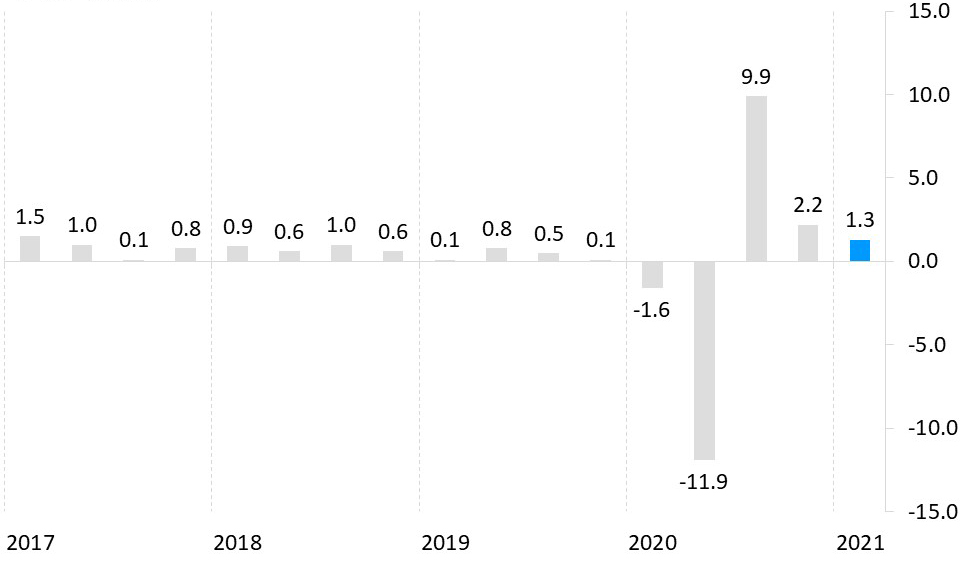
Source: Ontario Ministry of Finance.
Accessible description of chartManufacturing output declined 1.2% in the quarter due largely to transportation equipment (−7.9%). The overall decline was partially offset by an increase in electrical and electronic products (+10.3%).
Construction output was 5.7% higher, as both residential (+9.7%) and non-residential structures and engineering (+2.6%) increased.
Chart 12: Real GDP change by industry
Per cent, 2021Q1

*Other services includes transportation and warehousing; information and cultural; arts, entertainment and recreation; accommodation and food services; management of companies and enterprises; and other services.
Source: Ontario Ministry of Finance.
Primary industry output rose 3.1%, with increases in both agriculture and forestry (+0.6%) and mining (+7.6%).
Utilities output edged down 0.2%, following a 1.9% decline in the fourth quarter of 2020.
Service-producing industries output increased for the third consecutive quarter, with gains in professional and administrative services (+2.2%) and health, education and public administration (+2.0%).
Chart 13: Real GDP change by manufacturing industry
Per cent, 2021Q1
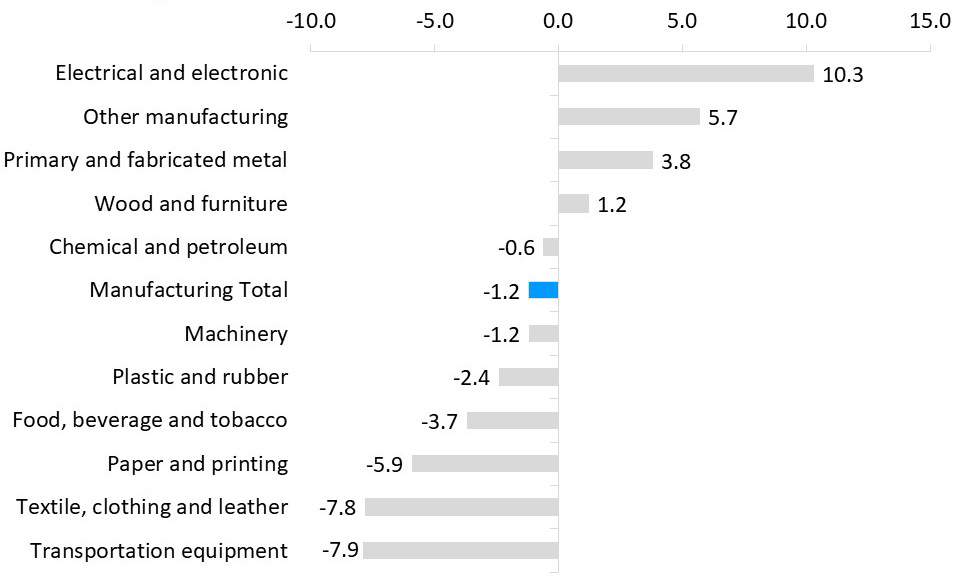
Source: Ontario Ministry of Finance.
Accessible description of chartJurisdictional comparisons
Ontario growth in context
Canadian real GDP increased 1.4% in the first quarter of 2021, following advances of 9.1% in the third quarter and 2.2% in the fourth quarter of 2020. Real GDP growth was supported by gains in residential investment (+9.4%), household spending (+0.7%) and exports (+1.5%). As of the first quarter, Canada’s real GDP was 1.7% below its level in 2019Q4.
Chart 14: Canadian real GDP growth
Per cent

Source: Statistics Canada.
Accessible description of chartQuebec’s real GDP increased 1.4% in the first quarter of 2021, following gains of 12.3% in the third quarter and 1.6% in the fourth quarter of 2020. As of the first quarter, Quebec’s real GDP was 0.8% below the level in 2019Q4.
Chart 15: Quebec real GDP growth
Per cent
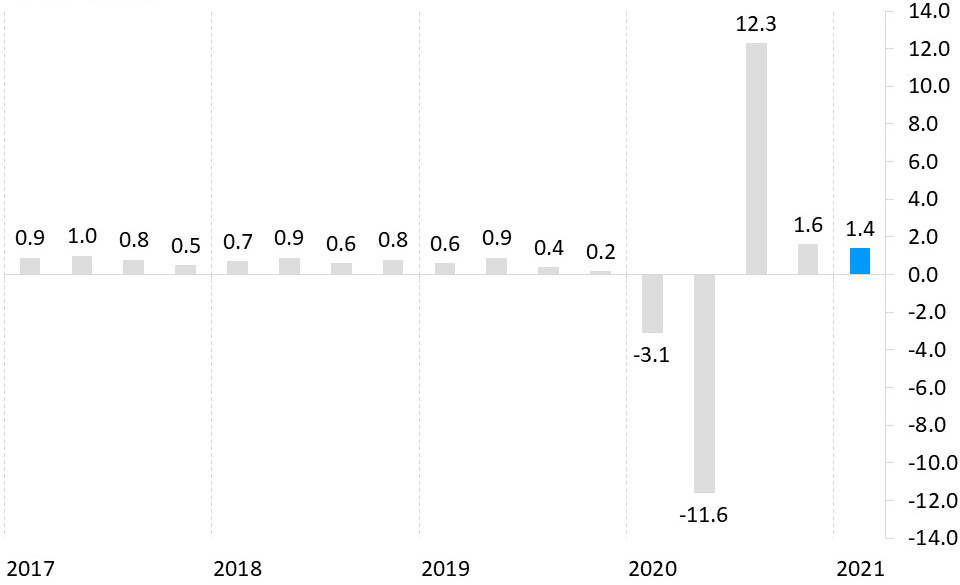
Source: Institut de la statistique du Queábec.
Accessible description of chartIn the U.S., real GDP increased 1.6% in the first quarter of 2021, following advances of 7.5% in the third quarter and 1.1% in the fourth quarter of 2020. As of the first quarter, U.S. real GDP was 0.9% below its level in 2019Q4.
Chart 16: U.S. real GDP growth
Per cent

Source: United states Bureau of Economic Analysis.
Accessible description of chartRecent economic developments
Global economic developments
Global recovery slows in 2021Q1
Many countries reported declines in real GDP in the first quarter of 2021 as second and third waves of the pandemic brought about renewed public health restrictions. Additionally, manufacturing activity was negatively impacted by supply-chain disruptions.
Chart 17: Real GDP growth
Per cent, quarterly rate
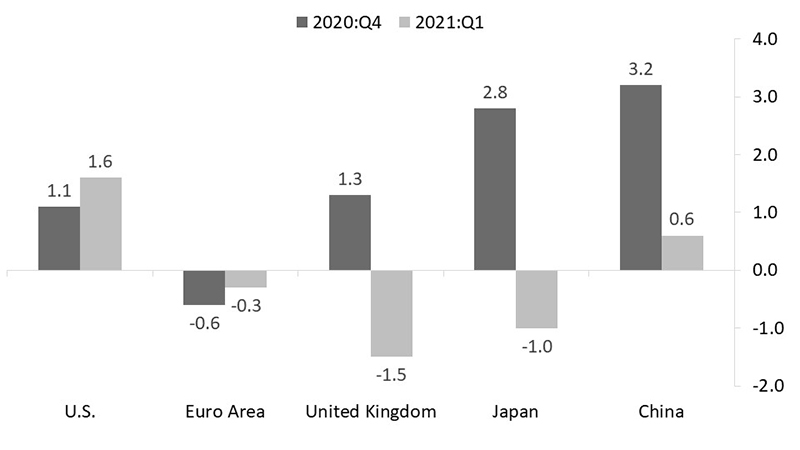
Sources: U.S. Bureau of Economic Analysis, Eurostat, U.K. Office for National statistics, Cabinet Office of Japan and National Bureau of Statistics of China.
Accessible description of chartReal GDP in the euro area decreased 0.3% in the first quarter of 2021, after declining 0.6% in the previous quarter. The United Kingdom’s real GDP was 1.5% lower in the first quarter, while Japan’s real GDP was 1.0% lower.
China’s economy expanded at a slower pace in the first quarter, with real GDP rising 0.6%, following a 3.2% increase in the fourth quarter of 2020. China’s real GDP surpassed its pre-pandemic level in the third quarter of 2020.
U.S. real GDP rose 1.6% in the first quarter of 2021, supported by further fiscal stimulus and a rapid vaccination roll out. The U.S. economy is now less than 1% below its pre-pandemic level in the fourth quarter of 2019.
Consumer prices have been rising in many countries in recent months, in part due to rising commodity prices and supply shortages. The U.S. Consumer Price Index (CPI) increased 5.0% year-over-year in May, after rising 4.2% in April. Core prices, all items less food and energy, rose 3.8% in May, the largest year-over-year increase since 1992.
Chart 18: U.S. Consumer price index
Per cent change, year-over-year
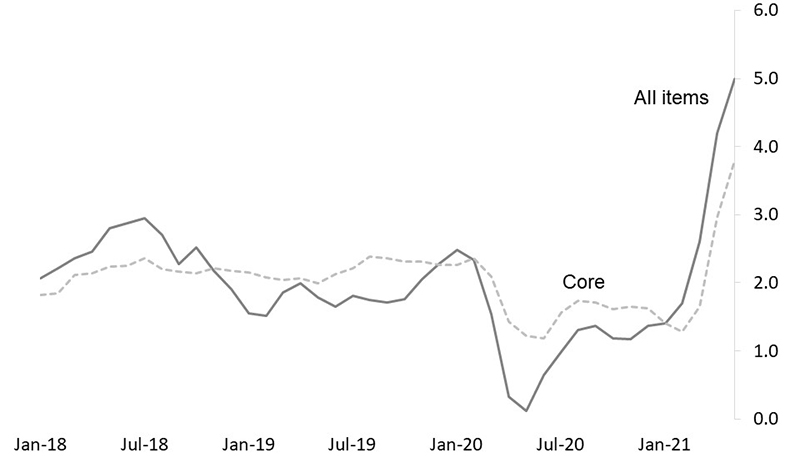
Source: U.S. Bureau of Labor Statistics
Accessible description of chartU.S. employment continued to recover in April and May with gains of 278,000 and 559,000, respectively. As of May 2021, the level of U.S. employment remained 5.0% lower than the February 2020 level. Although the U.S. unemployment rate continued to decline from the peak of 14.8% in April 2020 to 5.8% in May 2021, it remains above the pre-pandemic rate of 3.5%.
Chart 19: U.S. Labour market

Source: U.S. Bureau of Labor Statistics
Accessible description of chartCentral banks remain accomodative
Despite strengthening economic activity and rising inflation, the U.S. Federal Reserve (Fed) continued to provide support to the U.S. economy. The Fed has maintained accommodative monetary policy with increases in its asset holdings of US$120 billion per month and the target range for the federal funds rate of 0% to 0.25%.
Chart 20: Government of Canada 10-year bond rates
Per cent

Source: Bank of Canada.
Accessible description of chartThe European Central Bank (ECB) also continues to maintain its accommodative monetary policy with the deposit facility rate at −0.5% and asset purchases of €20 billion per month under its asset purchase program. The ECB intends to continue to make asset purchases under its pandemic emergency purchase program until at least March 2022.
In March, the Bank of Canada announced the discontinuation of emergency asset purchase programs for commercial paper, provincial bonds and corporate bonds and suspended repurchase agreement operations as market liquidity conditions have returned to normal. Subsequently, in April the Bank announced the slowing of its quantitative easing program, with weekly purchases of Government of Canada bonds lowered from at least $4 billion to $3 billion per week. The Bank continues to maintain its key policy interest rate at 0.25%.
Chart 21: Oil prices and the Canadian dollar

Sources: Bank of Canada and U.S. Energy Information Administration.
Accessible description of chartU.S. and Canadian longer-term government bond yields edged down in the second quarter of 2021, following significant increases over the first quarter. The Canadian 10-year government bond yield was 1.4% in mid-June, down from 1.7% at the end of March. The Canadian dollar rose from about 80 cents U.S. at the end of March to over 83 cents U.S. in early June, before depreciating back to near 80 cents U.S. in mid-June on a more hawkish U.S. Federal Reserve. Global oil prices continued to rise, with WTI oil price near US$70 per barrel in mid-June as strengthening economic activity supported oil demand. Major stock indices also trended higher, with Canada’s S&P/TSX Composite Index up over 7% compared to the end of March.
Chart 22: Stock market indices
Stock market index, Jan 4, 2018 = 100

Sources: Yahoo! Finance and STOXX.
Accessible description of chartEmployment
Labour market rebound
Ontario’s employment increased by a 116,900 jobs in June after declining in April and May. Since June 2020, employment has risen by 944,300 jobs. As of June 2021, employment was 190,400 (−2.5%) below the February 2020 level.
Chart 23: Ontario’s labour force
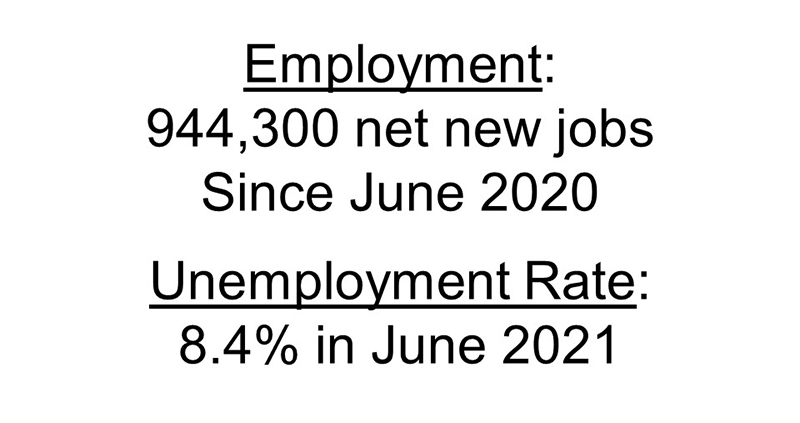
Source: Statistics Canada.
Accessible description of chartThe recovery in employment included increases in both full-time (+602,200) and part time (+342,100) jobs since June 2020.
Most of the increase in employment since June was in the private sector (+801,800). Public sector employment (+173,100) also increased, while self-employment (−30,600) decreased over the period.
Chart 24: Employment change since June 2020
Thousands
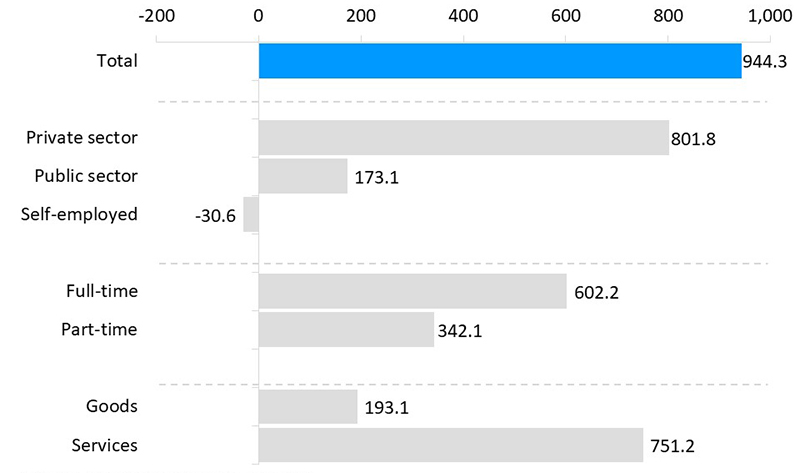
Number may not add due to rounding.
Source: Statistics Canada.
There were notable employment increases in both service-producing (+751,200) and goods-producing (+193,100) industries since June 2020.
In June 2021, the unemployment rate was 8.4%, down from a high of 13.5% in May 2020.
Chart 25: Ontario’s employment and unemployment rate
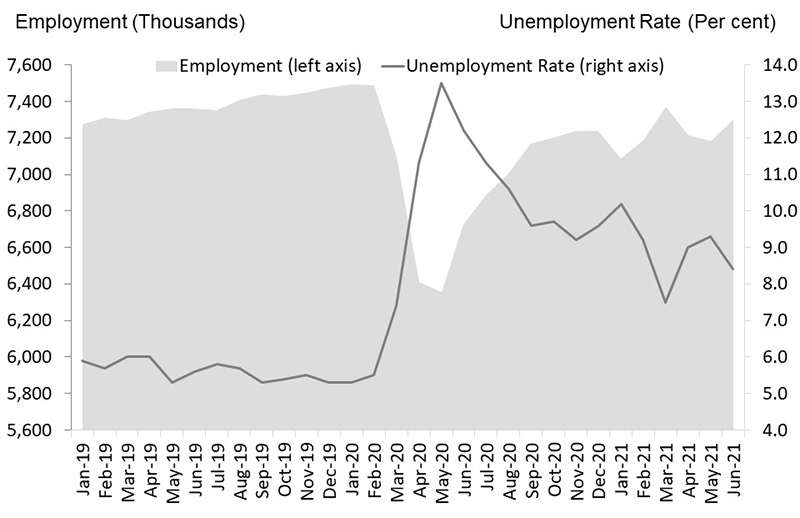
Source: Statistics Canada.
Accessible description of chartNote: More information on Ontario labour market performance can be found in the Quarterly Ontario Employment Report at:
/document/ontario-employment-reports
Consumer and business activity
Retail and wholesale trade and manufacturing sales
Ontario’s retail sales decreased by 13.4% in April, following an 11.7% increase in March. The decline was the second largest since the onset of the covid 19 pandemic. The decline in April was led by clothing and clothing accessories stores and general merchandise stores.
Chart 26: Retail sales
$ billions
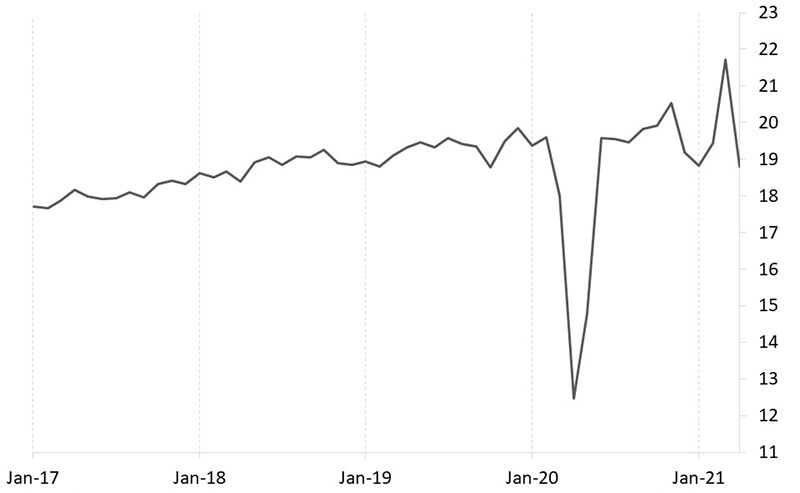
Last Data Point: April 2021
Source: Statistics Canada.
Wholesale trade decreased by 1.9% in April, following an increase of 0.6% in March. The decrease was led by lower sales of motor vehicles and parts (−8.4%) and miscellaneous products (−8.3%). The decline was partially offset by higher sales of building materials and supplies (+5.3%) and machinery equipment and supplies (+1.7%).
Chart 27: Wholesale trade
$ billions

Last Data Point: April 2021
Source: Statistics Canada.
Manufacturing sales decreased by 5.5% in April, following an increase of 3.1% in March. The decrease was primarily due to a large decline in transportation equipment sales (−26.9%), as sales of motor vehicles (−37.7%) and motor vehicle parts (−19.6%) were lower. The decline was partially offset by higher sales of machinery equipment (+15.3%), primary metal products (+5.3%) and chemical products (+3.8%).
Chart 28: Manufacturing sales
$ billions

Last Data Point: April 2021
Source: Statistics Canada.
Housing
Housing market overview
Sales of existing homes in Ontario deceased by 7.4% in May, following a 17.4% decline in April. These declines followed four consecutive months of increases in home resales. While the volume of sales has declined in recent months, they remained relatively high compared to historical norms and are 14.4% above the February 2020 level prior to the covid 19 pandemic.
Chart 29: Ontario Home resales
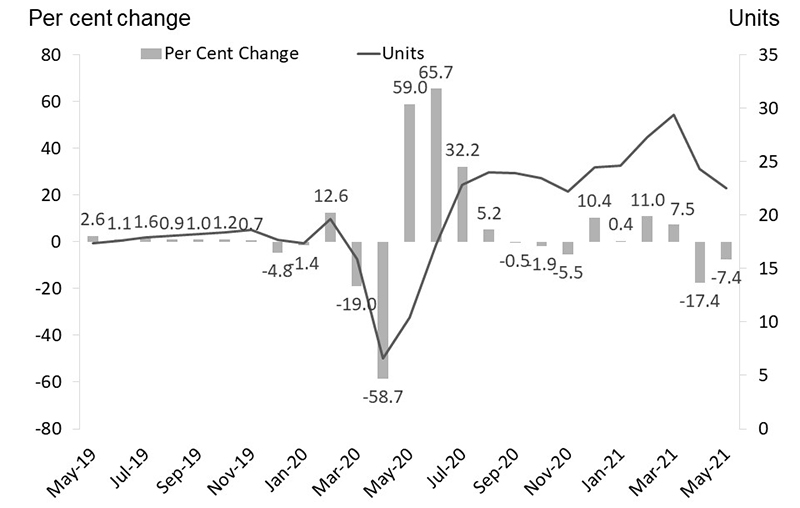
Source: Canadian Real Estate Association (CREA).
Accessible description of chartOntario average home resale prices were unchanged in May, after declining 2.3% in April. The easing in the last two months followed five consecutive monthly price increases and although below the all-time peak of $859,607 posted in March, the May price of $839,927 ranked as the third highest on record. Average resale prices have been boosted by a relatively larger portion of sales on detached homes.
Chart 30: Ontario home resale prices

Source: Canadian Real Estate Association (CREA).
Accessible description of chartHousing starts in Ontario decreased 8.3% in May, following a 17.9% decline in April. On a year-to-date basis, urban area housing starts increased 35.4% in the first five months of 2021, compared to the same period in 2020. Both single-detached (+62.4%) and multiple-unit (+27.1%) starts rose over the period.
Chart 31: Ontario Housing Starts
Units (Thousands, seasonally adjusted at annual rates)

Source: Canada Mortgage and Housing Corporation.
Accessible description of chartIn focus
2020 provincial comparison
All provinces across Canada were significantly impacted by the covid 19 pandemic in 2020. Overall, Canadian real GDP by industry declined by 5.2% in 2020. Alberta had the largest percentage decline (−8.2%) while Prince Edward Island had the smallest decline (−3.0%).
Chart 32: Industry GDP by province
Real GDP, per cent change, 2020 annual
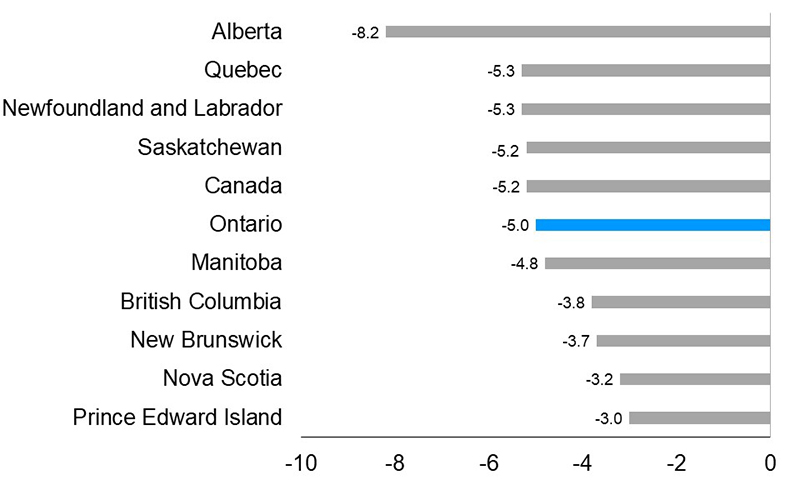
Source: Statistics Canada
Accessible description of chartEmployment across Canada declined by 5.2% in 2020. British Columbia had the largest percentage decline (−6.6%) while New Brunswick had the smallest decline (−2.6%).
Chart 33: Employment by province
Per cent change, 2020 Annual

Source: Statistics Canada
Accessible description of chartHousing markets across Canada posted strong growth in 2020. Home resales and average resale prices were up in all provinces. Canada-wide, home resales grew by 12.3% and average home resale prices grew by 13.0%. The strongest growth in resales was observed in Saskatchewan (+25.1%) while the strongest growth in average home resale prices was observed in Prince Edward Island (+18.7%). Alberta had the lowest percentage growth in both resales (+3.6%) and prices (+1.4%).
Chart 34: Housing markets across Canada
Per cent change, 2020 Annual

Source: Canadian Real Estate Association
Accessible description of chartAppendix
Ontario Economic Accounts release dates
The Fiscal Sustainability, Transparency and Accountability Act, 2019 states that the quarterly Ontario Economic Accounts should be released within 45 days of the Statistics Canada release of the National Income and Expenditure Accounts.
In compliance with the legislation, the OEA will be released according to the following schedule:
| Reference period | Within 45 days expected Statistics Canada release of National Income and Expenditure Accounts | Corresponding deadline for the release of Ontario Economic Accounts |
|---|---|---|
| Second Quarter (April-June) 2021 |
August 31, 2021 | By October 15, 2021 |
| Third Quarter (July-September) 2021 |
November 30, 2021 | By January 14, 2022 |
| Fourth Quarter (October-December) 2021 |
March 1, 2022 | By April 14, 2022 |
Appendix: Structure of the Ontario economy
Chart 35: Per cent share of nominal GDP, 2020

Note: Numbers may not add due to rounding.
Source: Statistics Canada
Appendix: How GDP is measured
The Ontario Economic Accounts provide measurements of GDP using three different methodologies, by expenditure, income and industry.
The GDP by expenditure approach defines GDP as the aggregate of all expenditures on final consumption, gross capital formation and net trade by consumers, governments and businesses that occur within Ontario’s economy over a given time period. This measurement of GDP can also be defined as the sum of consumer spending, gross investment, government spending and net trade.
The GDP by income approach equates GDP to the total income earned through contributions to production within Ontario’s economy by labour and capital over a given time period. That is, GDP is the sum of all wages and salaries paid to employees, the gross operating surplus of businesses, gross mixed income and indirect taxes less subsidies.
The GDP by industry approach measures GDP by calculating the total output of the goods and services producing industries within Ontario’s economy and subtracting the cost of intermediate inputs used in final production. This approach can also be referred to as the value-added approach as it quantifies the additional value generated by industries through the production of final products within the economy.
Chart 36: GDP approach on expenditure, income and production

For a full list of definitions used in the Ontario Economic Accounts, please see Statistics Canada’s System of Macroeconomic Accounts Glossary at https://www150.statcan.gc.ca/n1/pub/13-605-x/gloss/gloss-a-eng.htm.
List of data tables
View the related data tables at Ontario’s Open Data Catalogue
Accessible image description:
Chart 1
The chart indicates the per cent change in real and nominal GDP in the first quarter of 2021. Real GDP increased by 1.2% and nominal GDP increased 4.0% in the quarter.
Chart 2
The bar chart illustrates Ontario’s quarterly per cent real GDP growth from the first quarter of 2017 to the first quarter of 2021. Ontario has experienced real GDP growth over the entire period up until the first quarter of 2020 when real growth decreased by 1.5% followed by a steeper 12.0% decline in the second quarter. Real GDP rebounded by 9.7% in the third quarter of 2020 followed by smaller gains of 2.0% in the fourth quarter of 2020, and 1.2% in the first quarter of 2021.
Chart 3
The horizontal bar chart depicts the per cent change in Ontario’s real GDP and its components for the first quarter of 2021. Real GDP increased by 1.2% in the quarter, with increases in business investment (+8.1%), government (+1.3%), household consumption (+0.7%). Both exports (−0.8%) and imports (−0.4%) declined in the first quarter.
Chart 4
The bar chart shows the quarterly per cent change in real exports and imports from the first quarter of 2017 to the first quarter of 2021. Exports decreased by 0.8% in the first quarter of 2021, after edging down 0.2% in the fourth quarter of 2020, while imports declined 0.4% in the first quarter of 2021, after increasing 2.1% in the fourth quarter.
Chart 5
The bar chart illustrates Ontario’s quarterly per cent nominal GDP growth from the first quarter of 2017 to the first quarter of 2021. Ontario has experienced nominal GDP growth over the entire period, except for the first two quarters of 2020. Nominal GDP declined a record 12.9% in the second quarter of 2020, following a decrease of 2.3% in the first quarter of 2020. This was followed by a record 11.9% rebound in the third quarter of 2020, followed by more modest gains of 3.6% in the fourth quarter of 2020, and 4.0% in the first quarter of 2021.
Chart 6
The horizontal bar chart depicts the per cent change in nominal GDP and its components for the first quarter of 2021. Nominal GDP advanced 4.0% in the first quarter of 2021, with gains in compensation of employees (+2.6%) and net mixed income (+2.9%) in the quarter. Net operating surplus also increased, rising a sharp 17.1% in the first quarter.
Chart 7
The bar chart shows Ontario’s quarterly growth of employee compensation in per cent from the first quarter of 2017 to the first quarter of 2021. Compensation of employees has risen in every quarter over the period, except for the first and second quarters of 2020. Compensation of employees decreased by 8.3% in the second quarter of 2020, after declining 1.5% in the first quarter of 2020. This was followed by a 8.2% rebound in the third quarter and smaller gains of 2.6% in the both the fourth quarter of 2020 and the first quarter of 2021.
Chart 8
The bar chart illustrates Ontario’s quarterly growth of economy-wide prices in per cent from the first quarter of 2017 to the first quarter of 2021. Economy-wide prices decreased in both the first (−0.8%) and second (−1.0%) quarters of 2020. This was followed by gains in the next three quarters with the GDP deflator rising by 2.0% in the third quarter of 2020, 1.5% in the fourth quarter of 2020 and 2.8% in the first quarter of 2021.
Chart 9
The horizontal bar chart shows the per cent change in prices by expenditure component for the first quarter of 2021. With the exception of a flat import price, prices increased in the first quarter for all major spending components led by business investment (+4.1%), followed by the government sector (+1.8%), exports (+1.5%) and household consumption (+0.3%).
Chart 10
The bar chart illustrates Ontario’s quarterly growth of export and import prices in per cent from the first quarter of 2017 to the fourth quarter of 2020. Both export prices (−2.4%) and import prices (−1.25) declined sharply in the second quarter of 2020. Export prices rebounded by 1.9% in the third quarter while import prices declined by 1.0% in the quarter. Export prices increased by 0.8% in the fourth quarter of 2020, while import prices declined by 0.2% in the quarter. Export prices increased by 1.5% in the first quarter of 2021, while import prices were unchanged in the quarter. Since 2017, the largest gain in export prices occurred in the second quarter of 2018 when they rose 2.2%. The largest gain in import prices since 2017, occurred in the second quarter of 2018 when they rose 2.4%. The largest fall in import (−3.2%) and export (−3.1%) prices was in the third quarter of 2017.
Chart 11
The bar chart depicts Ontario’s quarterly growth of real GDP by industry in per cent from the first quarter of 2017 to the first quarter of 2021. Ontario real GDP increased by 1.3% in the first quarter of 2021, following a 2.2% increase in the fourth quarter. Real GDP by industry has grown over the entire period, the first two quarters of 2020. The strongest gain was recorded in the the third quarter of 2020 (+9.9%).
Chart 12
The horizontal bar chart illustrates the per cent change in real GDP by industry for the first quarter of 2021. The output of all industries increased 1.3% in the quarter. Output increased in goods-producing industries (+1.4%), with industry changes as follows: construction (+5.7%); primary (+3.1%); utilities (−0.2%) manufacturing (−1.2%). Output in the service industries increased 1.2%, including industry changes as follows: professional and administrative services (+2.2%); health, education and public administration (+2.0%); real estate, rental and leasing (+1.6%); finance and insurance (+0.7%); wholesale trade (+0.5%); retail trade (−0.2%); and other services (−0.6%).
Chart 13
The horizontal bar chart shows the per cent change in real GDP by the manufacturing industry for the fourth quarter of 2020. In total, output by manufacturing industries decreased 1.2% in the quarter. The change in output of each manufacturing industry is as follows: electrical and electronic (+10.3%); other manufacturing (+5.7%); primary and fabricated metal (+3.8%); wood and furniture (+1.2%); chemical and petroleum (−0.6%); machinery (−1.2%); plastic and rubber (−2.4%); food, beverage and tobacco (−3.7%); paper and printing (−5.9%); textile, clothing and leather (−7.8%); and transportation equipment (−7.9%).
Chart 14
The bar chart illustrates Canada’s quarterly per cent real GDP growth from the first quarter of 2017 to the first quarter of 2021. Canada has experienced real GDP growth over the entire period up until the first quarter of 2020 when real growth decreased by 2.0% followed by a steeper 11.3% decline in the second quarter. Real GDP rebounded by 9.1% in the third quarter, followed by a 2.2% increase in the fourth quarter of 2020, and a 1.4% advance in the first quarter of 2021.
Chart 15
The bar chart illustrates Quebec’s quarterly per cent real GDP growth from the first quarter of 2017 to the first quarter of 2021. Quebec has experienced real GDP growth over the entire period, with the exception of the first and second quarters of 2020. Quebec real GDP declined 11.6% in the second quarter of 2020, following a decrease of 3.1% in the first quarter. Real GDP rebounded by 12.3% in the third quarter, followed by a 1.6% increase in the fourth quarter of 2020 and a 1.4% advance in the first quarter of 2021.
Chart 16
The bar chart illustrates the U.S.’s quarterly per cent real GDP growth from the first quarter of 2017 to the first quarter of 2021. The U.S. has experienced real GDP growth over the entire period up until the first quarter of 2020 when real growth decreased by 1.3% followed by a steeper 9.0% decline in the second quarter. Real GDP rebounded by 7.5% in the third quarter of 2020 followed by a 1.1% increase in the fourth quarter of 2020 and a 1.6% advance in the first quarter of 2021.
Chart 17
This bar chart shows quarterly percentage changes in real GDP for the U.S., the euro area, the United Kingdom, Japan and China for the fourth quatar of 2020 and first quarter of 2021. U.S. real GDP increased 1.6% in the first quarter of 2021, after increasing 1.1% in the fourth quarter of 2020. Euro area real GDP decreased 0.3% in the first quarter following a 0.6% fall in the fourth quarter. Real GDP in the United Kingdom decreased 1.5% in the first quarter following a 1.3% rise in the fourth quarter. Japan’s real GDP decreased 1.0% in the first quarter and increased 2.8% in the fourth quarter. China’s real GDP advanced 0.6% in the first quarter after increasing by 3.2% in the fourth quarter.
Chart 18
This line chart shows year-over-year percentage changes in the U.S. Consumer Price Index (CPI) from January 2018 to May 2021. Total and core CPI year-over-year growth was near 2% from January 2018 to March 2020 and then was weaker than 2% for the rest of 2020. Total and core CPI year-over-year growth rose above 2% in early 2021. In May 2021, total CPI increased 5.0% year-over-year and core CPI increased 3.8% year-over-year.
Chart 19
This chart shows the U.S. employment level in millions and unemployment rate in per cent from January 2018 to May 2021. The employment level steadily rose from 147.6 million in January 2018 to 152.5 million in February 2020. Employment then declined to 130.2 million by April 2020 before rising to 144.9 million by May 2021.
The unemployment rate declined from 4.0% in January 2018 to 3.5% in February 2020. It then rose to 14.8% in April 2020 before gradually easing to 5.8% in May 2021.
Chart 20
This line chart shows rates for Government of Canada 10-year bonds from January 2018 to mid-June 2021. The rate was around 2.0% throughout 2018 and then declined to a low of 0.4% in August 2020. The rate then rapidly increased to a peak of 1.6% in mid-March before falling to 1.4% in mid-June 2021.
Chart 21
The line chart shows the daily West Texas Intrmediate (WTI) oil price ($US per barrel) and Canadian dollar exchange rate (cents U.S.) between January 2018 and May 2021. The Canadian dollar declined from over 80 cents U.S. in January 2018 to 77 cents U.S. by the end of 2019 before sharply declining to below 70 cents U.S. by March 2020. The dollar then rose to around 83 cents U.S. by mid-June 2021.
WTI oil prices rose to a peak US$77 per barrel in June 2018, before declining to around US$45 per barrel at the end of 2018. Prices trended up slightly in 2019 to about US$60 per barrel in December before declining sharply and briefly reaching below US$10 per barrel in late April 2020. The oil price has since gained to around US$71 per barrel in mid-June 2021.
Chart 22
The line chart shows the daily value of the S&P 500, Nikkei, S&P/TSX Composite and Euro Stoxx 50 stock indexes from January 2018 to June 2021. All are indexed to January 4, 2018 equaling 100. All indices trended upwards in 2019 and early 2020, peaking in late February 2020, before declining sharply and reaching a trough in March 2020. All indices have recovered strongly and are well above their February 2020 peaks, particularly the S&P 500 and Nikkei.
Chart 23
The chart indicates that Ontario has added 944,300 net new jobs since June and that the unemployment rate was 8.4% in June 2021.
Chart 24
The bar chart illustrates the breakdown in the change in employment measured in thousands of jobs since June 2020. As of June 2021, total employment has risen by 944,300 net new jobs. Changes were as follows: private sector, a gain of 801,800 jobs; public sector, a gain of 173,100 jobs; self-employed, a decline of 30,600 jobs; full-time, a gain of 602,200 jobs; part-time, a gain of 342,100 jobs; goods, a gain of 193,100 jobs; and services, a gain of 751,200 jobs.
Chart 25
The chart shows Ontario’s monthly employment level as a shaded area and unemployment rate as a line from January 2019 to June 2021. The unemployment rate trended down from 5.9% in early 2019 to 5.5% in February 2020 and had increased to 13.5% in May 2020 and has since trended down to 7.5% in March 2021 before rising to 9.3% in May 2021 and declining to 8.4% in June 2021. Employment has increased steadily over the period from about 7.3 million in January 2019 to about 7.5 million in February 2020 and had declined to 6.4 million in May 2020 and rising throughout 2020 rebounding to 7.3 million In June 2021.
Chart 26
The line chart shows Ontario’s retail sales in billions of dollars from January 2017 to April 2021. Ontario’s retail sales have trended upwards from $17.7 billion in January 2017 to $19.6 billion in February 2020. There was a sharp decline to $12.5 billion in April 2020. This was followed by a sharp rebound in May and June of 2020. Retail sales increased to $21.7 billion in March 2021, but declined to $18.8 billion in April 2021.
Chart 27
The line chart shows Ontario’s wholesale trade in billions of dollars from January 2017 to April 2021. Ontario’s wholesale trade has trended upwards from $30.6 billion in January 2017 to $34.6 billion in February 2020. There was a sharp decline to $23.0 billion in April 2020, followed by a sharp rebound between May 2020 and July 2020. Wholesale trade increased to $35.8 billion in March 2021, but declined to $35.1 billion in April 2021.
Chart 28
The line chart shows Ontario’s manufacturing sales in billions of dollars from January 2017 to April 2021. Ontario’s manufacturing sales have fluctuated over the period, largely remaining between $22 billion and $27 billion. Manufacturing sales sharply declined to $14.0 billion in April followed by a sharp rebound between May and July of 2020. Manufacturing sales edged up to $25.2 billion in March 2021, but declined to $23.9 billion in April 2021.
Chart 29
The combination line and bar chart shows Ontario’s home resales in both thousands of units (right axis) and per cent change (left axis) from May 2019 to May 2021. Home resales were fairly stable in 2019 averaging around 17,500 units per month. After edging down to the 17,400 range in January 2020, Ontario home resales increased by 12.6% in February 2020 to 19,600 units, before declining sharply in March (−19.0%) and April (−58.7%), with home resales declining to just 6,600 units in April. Beginning in May 2020, home resales began to rebound strongly, rising over the next four months, reaching a record high of over 24,000 units in August. This was followed by a period of easing as home sales declined in the September to November period with home resales declining to just under 22,200 units in November. Home resales increased steadily over the next four months rising to 29,350 units in March 2021. This was followed by a sharp 17.4% decline in April to 24,257 units and by a 7.4% decline in May to 22,456 units.
Chart 30
The combination line and bar chart shows the average resale price on an Ontario home in thousands of dollars (right axis) and per cent change (left axis) from May 2019 to May 2021. The chart shows resale prices growing at a modest pace throughout 2019 with the average resale price of an Ontario home hitting a high of close to $644,000 in December 2019. Resale prices continued to rise in the first two months of 2020 reaching a new high of 677,000 in February. The average home resale price declined in March (−2.3%) and April (−13.4%) , before rebounding over the next four months, advancing from $608,800 in May 2020 to an all-time high of around $752,600 in August. This was followed by a period of easing as home resale prices declined in September (−1.3%) and October (−0.6%) with the average home resale price declining to about $738,500 in October. Average home prices increased over the next five months with the average resale price of an Ontario home reaching an all-time high of $859,607 in March 2021. This was followed by a 2.3% decline in average prices in April to $839,561. In May prices rose slightly to $839,927.
Chart 31
The line shows Ontario’s housing starts in units (seasonally adjusted at annual rates) from May 2019 to May 2021. Ontario’s housing starts were volatile over the period, with highs of 117,500 units in August 2020 and a trough of 50,400 units in May 2019. After reaching the high in August 2020, housing starts declined by 31.4% in September to 80,600 units. This was followed by two months of modest gains with housing starts reaching 86,400 units in November. Housing starts declined by 17.0% in December followed by sharp 39.6% increase in January 2021. After dipping 12.0% in February, starts surged 47.7% in March to 130,452 units. This was followed by declines of 17.9% in April and 8.3% in May with housings starts hitting a level of 98,185 units in May.
Chart 32
The bar graph depicts the per cent change in real GDP (by industry) in 2020 for Canada and each of the 10 provinces. Ontario real GDP, depicted in blue, declined by 5.0% in 2020. The largest decline in real GDP among provinces was observed in Alberta (−8.2%) while the smallest decline was observed in Prince Edward Island (−3.0%). Across Canada, real GDP declined by 5.2% in 2020.
Chart 33
The bar graph depicts the per cent change in total employment in 2020 for Canada and each of the 10 provinces. Ontario employment, depicted in blue, declined by 4.8% in 2020. The largest decline in employment among provinces was observed in British Columbia (−6.6%), while the smallest decline was observed in New Brunswick (−2.6%). Across Canada, employment declined by 5.2% in 2020.
Chart 34
The bar chart depicts the per cent change in home resales (in gray) and the per cent change in average home resale prices (in blue) in 2020 for Canada and each of the 10 provinces. Ontario home resales (depicted in the darker shade of gray) grew by 8.8% in 2020, the second lowest growth rate among provinces, ahead of only Alberta (+3.6% growth in home resales). But Ontario average home resale prices (depicted in the darker shade of blue) grew by 16.0% in 2020, which was the third largest growth rate among provinces, behind only Prince Edward Island (+18.7% growth in average home resale price) and Quebec (+16.5% growth in average home resale price). Across Canada, home resales grew by 12.3% and average home resale prices grew by 13.0% in 2020.
Chart 35
This pie chart shows the percent share of nominal GDP by industry for 2020. Goods-producing industries accounted for 21.9% of Ontario’s nominal GDP with industry shares as follows: manufacturing (10.7%), construction (7.2%), utilities (1.8%) and primary industries (2.2%). Services-producing industries accounted for 78.2% of Ontario’s nominal GDP with industry shares as follows: real estate, rental and leasing (14.2%), health and education (13.0%), wholesale and retail trade (10.9%), finance and insurance (10.5%), public administration (7.8%) transportation and warehousing (3.3%), information and culture (3.8%) and other services (14.7%).
Chart 36
- Expenditure Approach
- Sum of expenditures of all sectors of the economy
- Consumer Spending + Investment + Government Spending + Exports – Imports
- Income Approach
- Sum of all incomes
- Wage and Salaries + Profits + Mixed Incomes + Indirect taxes – Subsidies
- Production Approach (GDP by Industry)
- Sum of value added in all industry sectors
- Output of Goods Producing Industries + Output of Services Producing Industries – Intermediate Inputs

